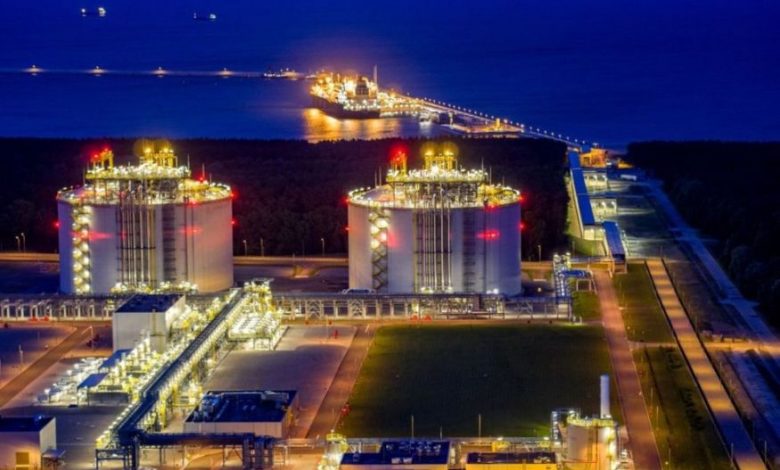Europe relies on liquefied natural gas
Europe was seriously thinking about reforming the natural gas supply system, trying to reduce its dependence on gas pipelines per se, and on Russian in particular, by increasing the fleet of ocean tankers capable of transporting liquefied gas. The EU is going to create new type of existing oil hub ports – with facilities for transshipment and storage of liquid gas (LNG).
For Estonia, the possible shift of the tip of world natural gas trade from a “pipe” to a container for liquefied natural gas can turn out to be a considerable profit. It all depends on how quickly a country responds to changes and fits into new trading schemes.
Today, most of the EU’s imported gas – and with its help in Germany and the UK, for example, today produce about 20 percent of the electricity consumed – is pumped through pipelines from Russia, Norway and Algeria. Gas prices are fixed in one- or five-year contracts and are tied to the price of oil, but fluctuate on a smaller scale.
According to experts, the rapid growth of the global liquefied natural gas market in the next two to three years will “untie” its prices from the cost of a more influential “relative” – oil. Turnovers of transactions with LNG will grow so much that the trading scheme will become similar to oil trading – the contents of tankers on the way will be sold and resold until the maximum price is reached.
“This will provide us with access to the same global market as the oil market,” said Fernando Espuni, representative of the EU Energy Commissariat. “If suddenly someone cannot sell you gas, you will not find yourself in a difficult position, but just buy it elsewhere.”
It is worth noting that the discussion of such a serious reform of gas supplies flared up in Europe at a time when new difficulties began in relations between Ukraine and Russia. According to many Europeans, it was precisely this kind of friction that caused the January disruption of Russian gas supplies through Ukraine.
“The increased use of LNG opens up the possibility of expanding the circle of suppliers. We will cease to depend on Kazakhstan or Russia. It will be possible to import gas from the Middle East, from Venezuela, from anywhere, ”said Ben Van Gills, one of the directors of the well-known analytical company Ernst & Young, to the EUobserver news website.
“LNG can begin to play a key role in ensuring supply stability,” said Sverre Koyedal, spokesman for Statoil, a well-known Estonian company. – Now there is the opportunity to sell gas to the United States or anyone else. Due to the Arctic Circle, oil and gas will soon become an important part of supplies to the USA and the EU. ”
Brussels is joining the global game around liquefied gas, calling it a key opportunity in its March energy program to diversify energy supplies. In addition, for investments in the development of the LNG market, the EU makes an exception to the rather harsh all-Union law prohibiting state assistance to private entrepreneurship. Thus, the UK, which decided to invest state funds in private enterprises of gasification of seaport terminals, easily received permission from the European Commission.
And one of the few concrete results of the EU-US summit was the phrase in the outcome document “Promote the Development of the LNG Market”.
By the end of 2007, a new natural gas liquefaction plant, built by Statoil in Hammerfest, in northern Norway, will be operational. Through a 143-kilometer steel pipe, the plant will receive gas from the Snow White field in the Barents Sea, cool it to a temperature of -163 ° C, and then it will be pumped into specially built four tankers that will make 70 flights a year, delivering gas to the USA, France and Spain.
Each of the tankers will deliver as much gas per flight as necessary in order to provide energy to a city the size of Amsterdam within six months. In a year, the plant will produce 4 billion cubic meters of liquefied natural gas – and most of it has already been bought out under long-term contracts by American and Spanish customers. But 1.7 billion cubic meters are intended for free sale through two French firms.
True, this same example also recalls the insufficient yet profitability of such projects in comparison with the laying of gas pipelines. Snow White will bring Statoil up to 2 billion euros per year, but the cost of investment is very high. Every 6 billion cubic meters of gas delivered to customers will require 7 billion euros of investment. And the Russian-German gas pipeline at the bottom of the Baltic Sea will cost 4 billion, supplying 55 billion cubic meters per year.
Farther north than Snow White, in the Barents Sea, the Russian company Gazprom is preparing to launch the largest liquefied gas production project in human history – at the Stockman gas field, which is ten times the size of Snow White. Gazprom will choose its partners in this gigantic undertaking from among five applicants – American, French and Norwegian companies – and will name it during the G8 summit, which will soon be held in St. Petersburg. The level of “audience” speaks for itself.
Russia is only building its first liquefied natural gas plant – as part of the Sakhalin-2 project. But the prospects are excellent in this market, if only for the reason that, as American geologists point out, owns 30 percent of the world’s proven natural gas reserves and up to 25 percent of the estimated reserves. By the way, these figures cast doubt on Europeans’ hopes to reduce their dependence on Russian supplies with the switch to LNG. So, for Estonia there may be a “warm” place on the way of Russian liquefied gas to Europe.
This post is also available in:
 English
English  Русский (Russian)
Русский (Russian)





